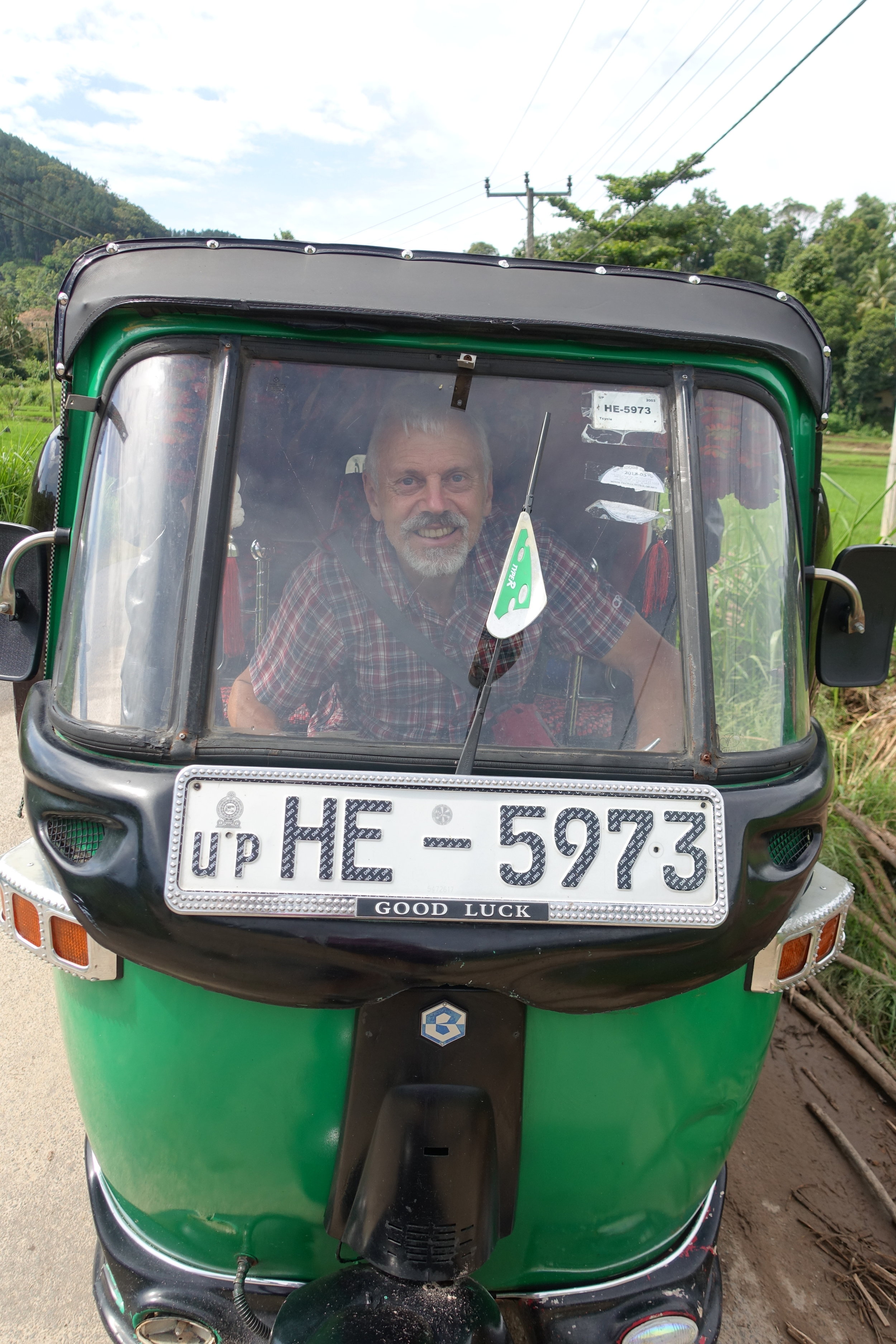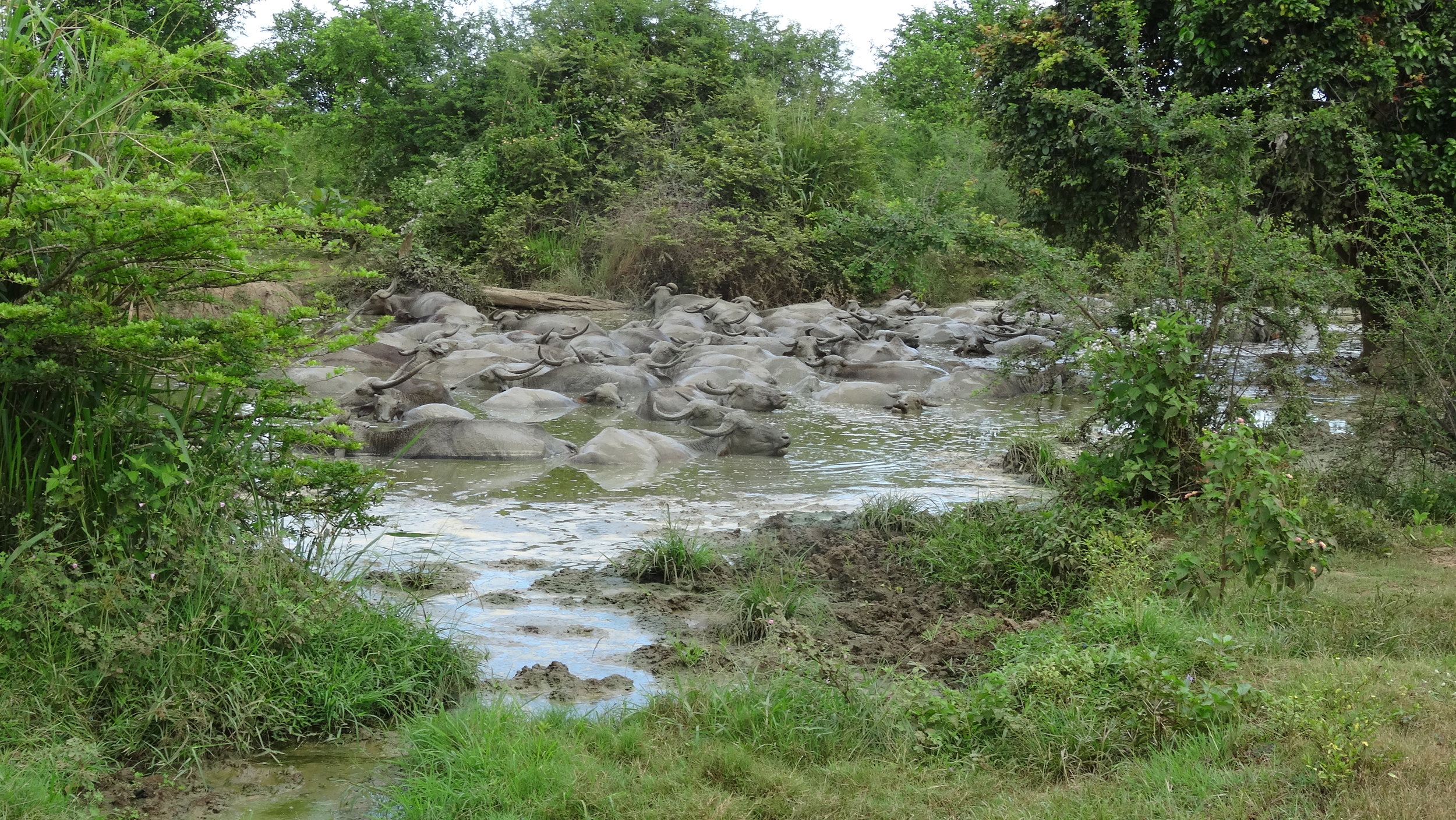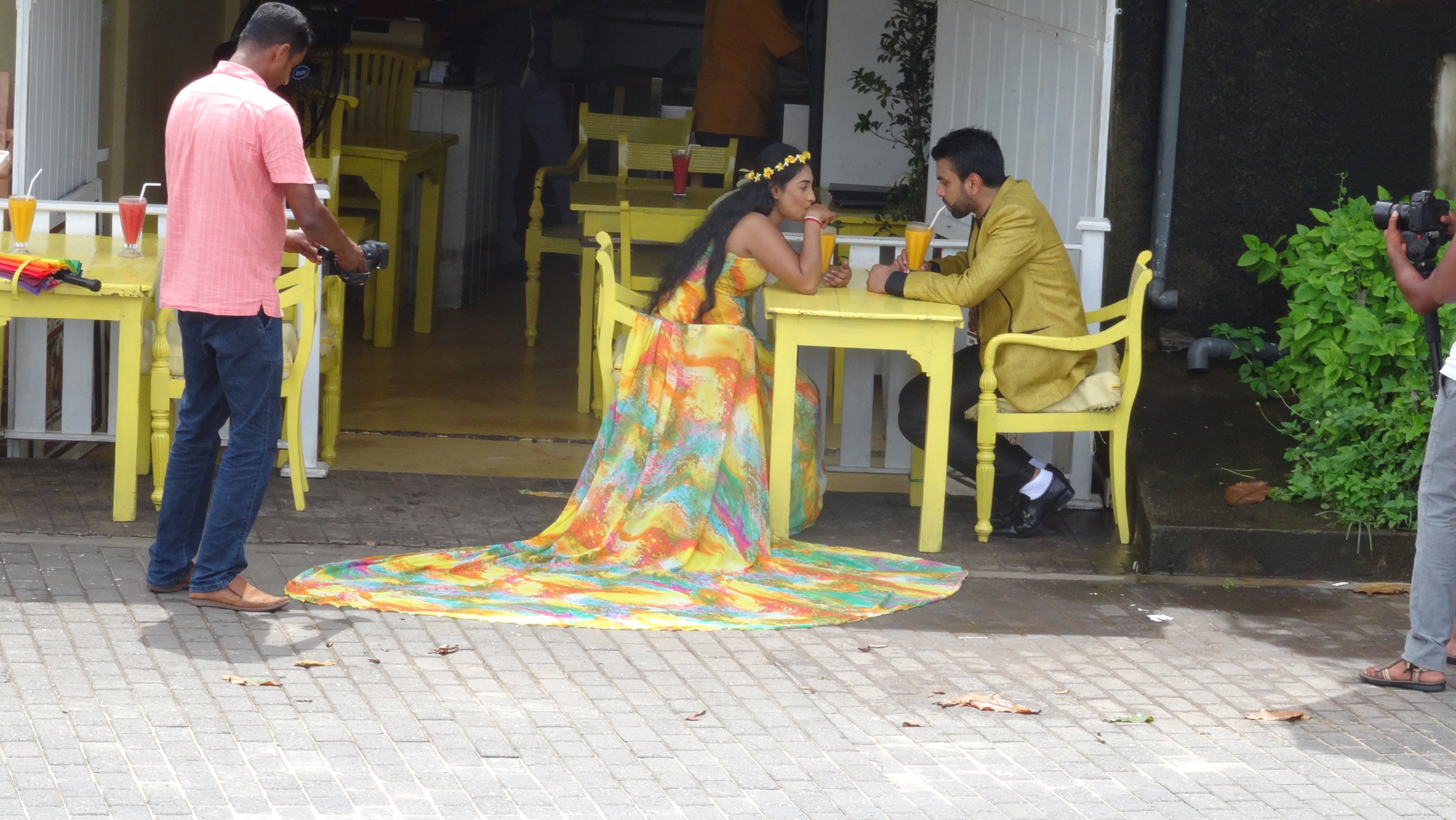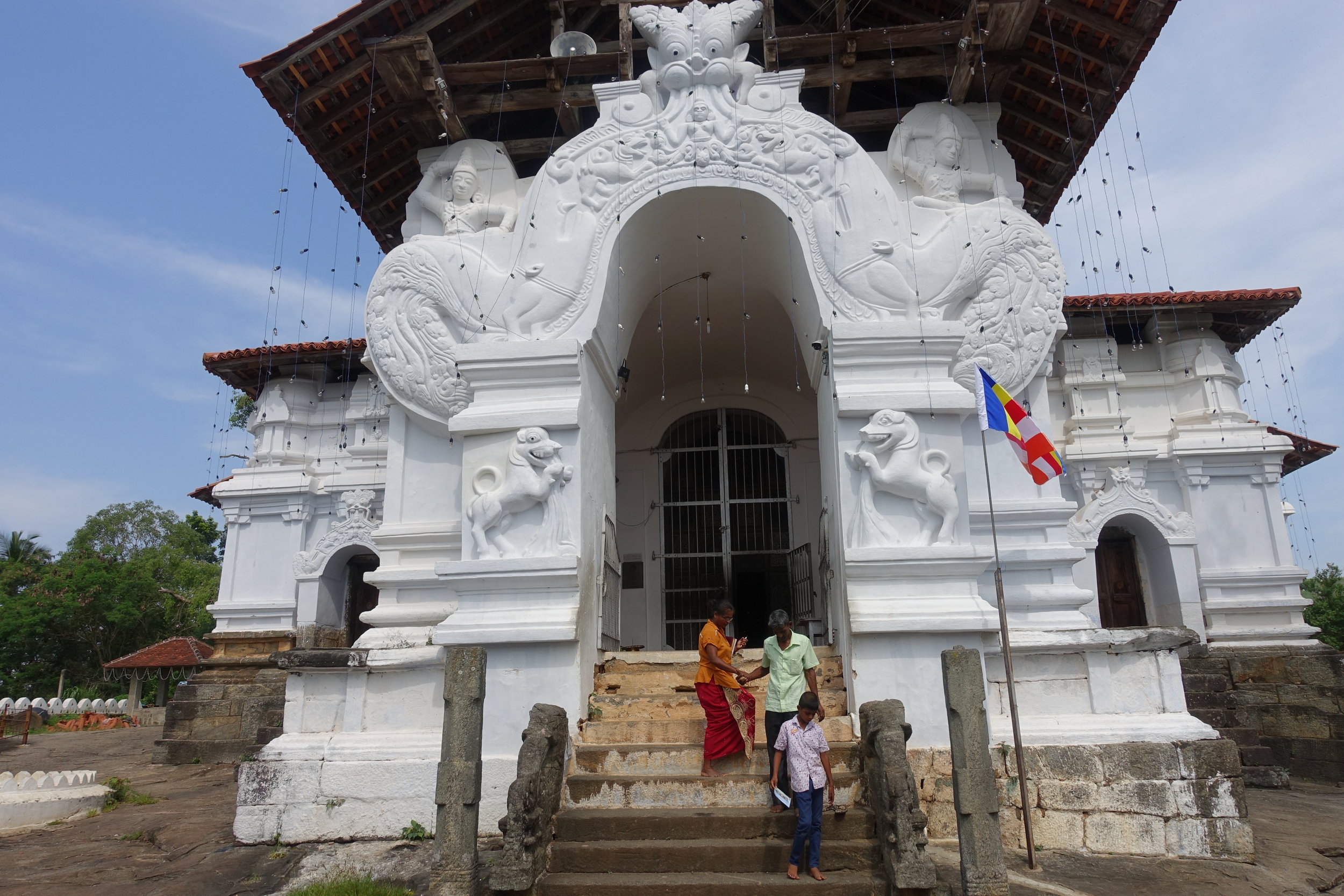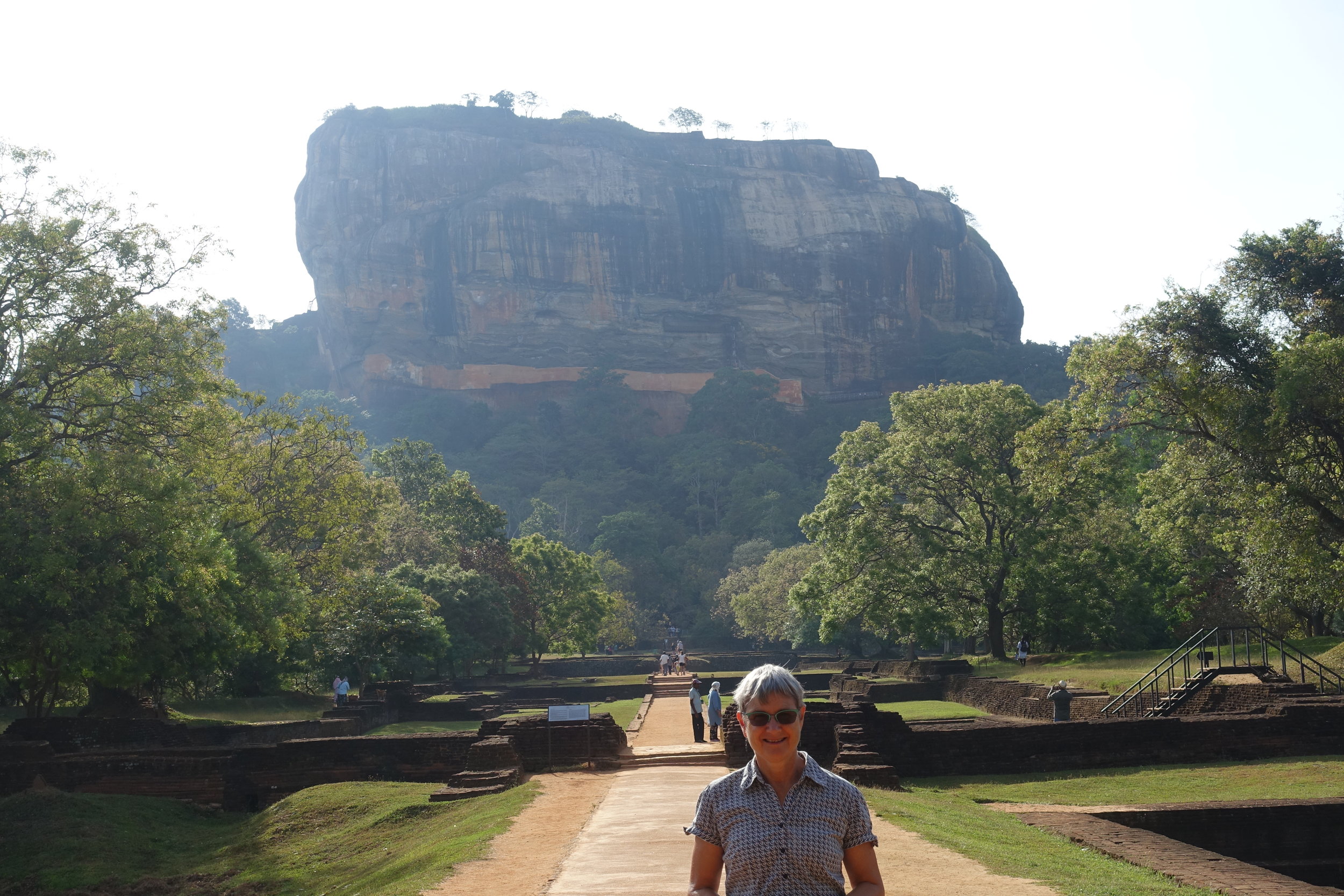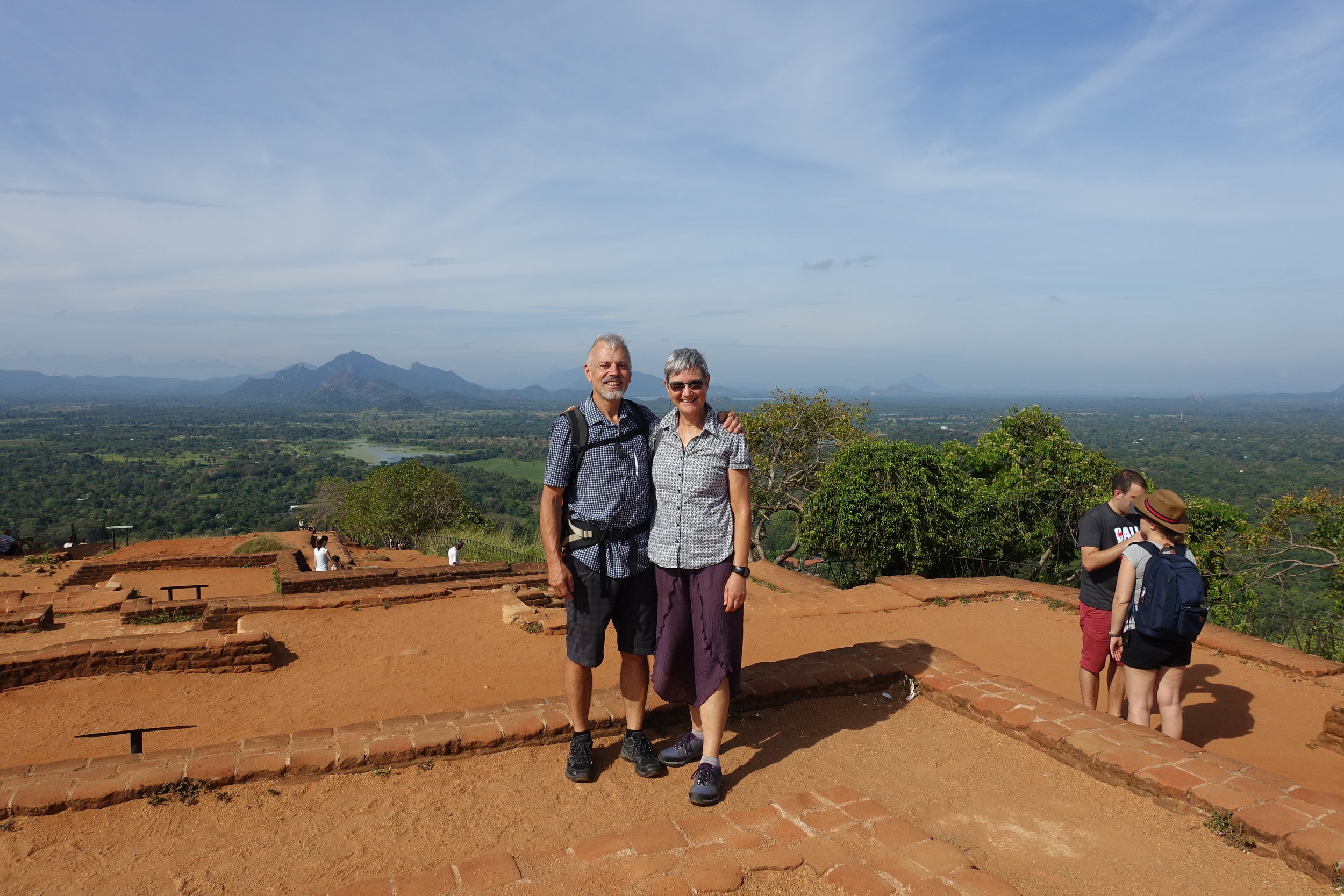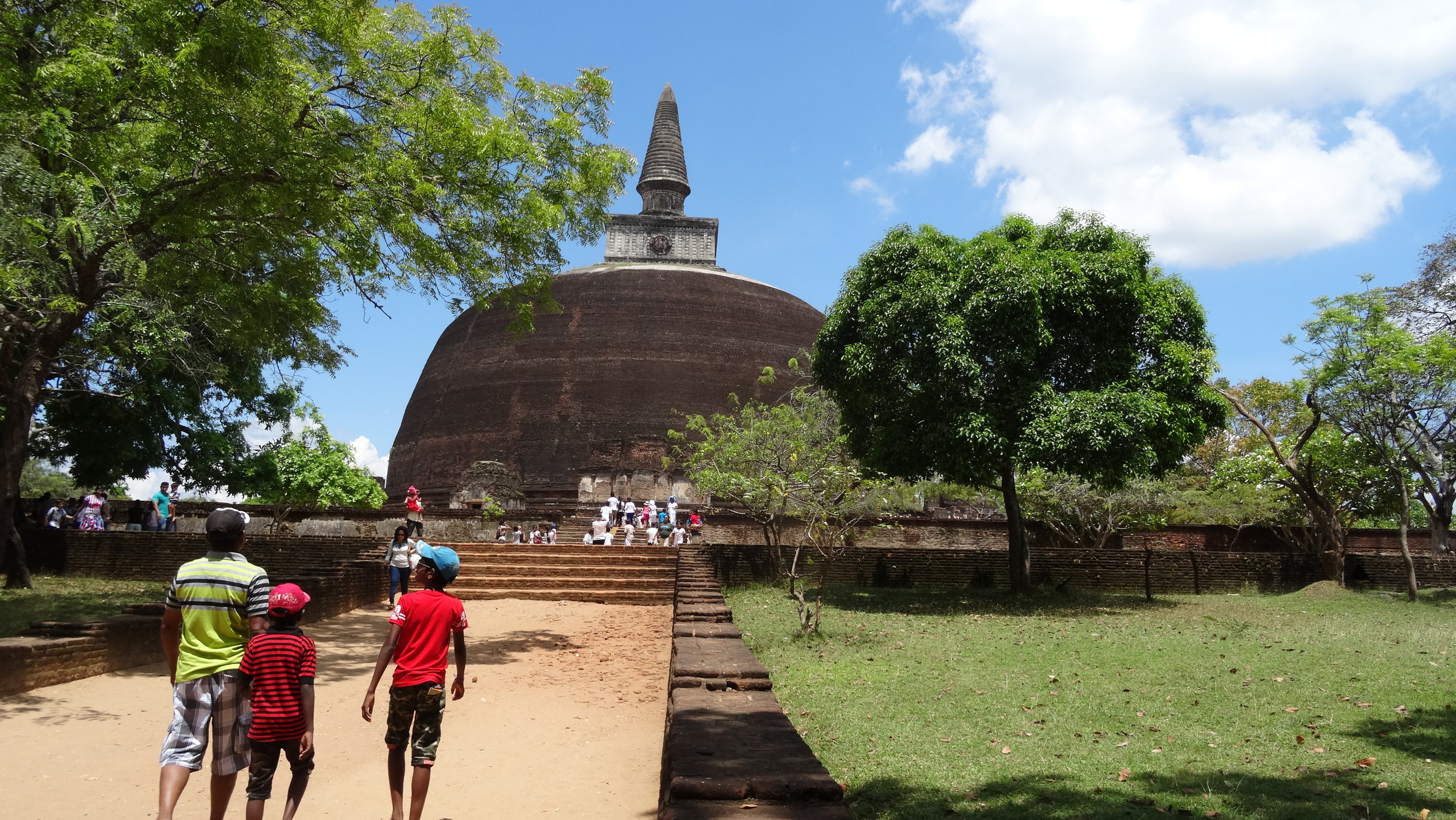Sri Lanka: Ella to Colombo - including Udawalawa National Park, Talalla, Uluwatuna
Louise George
Our calf muscles are a bit stiff but we’ve planned a day of walking. It’s May Day Public Holiday; usually held 1st May but deferred this year because last Monday was a Poya Public Holiday.
The walking route to Ella from the height of our accommodation is down a long section of concrete steps and then along the railway. There is a narrow track beside the line but with puddles and sometimes overhanging long grasses to brush against us at face height, we do what the locals do, and take no notice of the signs pointing out the danger of walking on the line, and make our walk easier by stepping from sleeper to sleeper, first a section on solid concrete ones and later, old wooden sleepers, that squelch in the moist mud. We walked a number of kilometres, along the railway line, through the short tunnel, to Nine Arch Bridge, a span of 91 metres at a height of 24 metres. The bridge was commissioned by the British in 1941. We took our place in the queue for a photo, along with many locals who were also out walking. I took my hat off for the photo and put it on the ground with the bag. We were about to walk on, when I said to Nev that it seemed odd, but my ear felt like it was sweating. On removing my hat he told me there was a leech attached to the top of my ear. Those around me panicked and one person, (Tasmanian)who fortunately has a leech phobia, had a bag of salt to sprinkle on it. It soon curled up and dropped to the ground but not before Nev took a photo of it. The Tasmanian took great delight in stomping the leech flat. From that time, I am constantly checking myself when we walk through long grasses.
We climbed a dirt track from the railway, and on joining a road came across a juice bar, that had a view directly down to the bridge. Sipping on passionfruit juice, we’d timed it right to see the crowds on the bridge scuttle, and the morning train crossed. More climbing and steps took us to the top of Little Adam’s Peak, but by the time we arrived, cloud had obscured the view. On heading towards town, raindrops fell just as we were passing a restaurant. The impending rain and attraction of a sign of Espresso, cappuccino, latte, seemed like a great time to stop. The restaurant had no coffee and we were too late for small meals. Nev ordered and I ate a small portion of his meal. By now it was 3 p.m. and we’d booked to attend a cooking class at 5, so I didn’t want to spoil my appetite. Rain bucketed down for the next 2 hours. We shared our table with an English couple, Cherry, Keith and daughter Kate. Kate and Keith, 70, had just completed Lanka Tuk Tuk challenge, and we loved hearing of their adventure. If anyone is crazy enough, here is a link to the organisation that runs that challenge; https://www.largeminority.travel/lanka-challenge/ (A few days later, in a car park in Unawatuna we saw two Tuk Tuks emblazoned with New Zealand stickers and flags that appear to have also participated in the event).
There were four of us at the Ella Rocks Cooking class. The Sri Lanka curries are mild and flavoursome. We cooked rice, yellow dhall, bean curry, pumpkin curry and coconut roti, all from scratch, even made the coconut milk; all very delicious, with a side of avocado salad. Dessert was a sweet, nutty, cinnamon, sago pudding, a National dish called Sauw.
Here is one very simple cooking tip you may like to use: when cooking rice, add a few cloves of Garlic (in their skins) to the water. They come out creamy, just like baked garlic. You can also do this when cooking yellow lentils for dhall.
Our calf muscles are tight! We’re going to have a ‘taking it easy’ day but as Ella Hide View is perched at the top of a hill, our outing starts with a stiff walk down the steps and along the railway to Ella. It’s easy to locate the bus stop and catch a blue one, that takes over the road as it speeds downhill around tight corners, towards Wellawaya. We get off after 6 km at the Rawana Ella falls, that drop an impressive 19 metres down to the roadside. There are large boulders and warnings not to climb them, as to date 36 people have died at this waterfall. The road each side was bordered by stalls selling peeled and sliced Mango, temptingly displayed as fruit strips protruding from small plastic bags. We’d had the most amazing breakfast at Ella Hide View that had included a fruit starter of slices each of mango, papaya, watermelon, orange, pineapple, small banana and half a passion fruit; so couldn’t be tempted. There is a bus stop nearby and we enjoy the wait for a return bus, as there are monkey’s antics to be entertained by.
Back in Ella, we’re tempted by a coffee sign, only to find there is no power to restaurants in town, so again coffee is elusive. There is stormy cloud filling the space between the steep hills that border the valley of Ella Gap, so we returned to Ella Hide View to sit out what becomes torrential rain, that fell for a few hours. We holed up for an admin afternoon. Our view was towards little Ella Falls and they had grown from two riverlets of silver to a solid burnished brown curtain, that was held apart by a ridge of green shrubbery. We wondered if Rawana Ella was cascading over the road!
Ella Hide View do not do lunch, and after such a large breakfast we thought that wouldn’t matter, but after the accumulated walking over the past few days, by 3 p.m. I’m feeling light headed. The easiest way to town is another railway line walk, but this time we decided to follow a sign pointing down a road to Ella City, and found ourselves walking down a steep slippery narrow road with tourist accommodation built into the slopes. No wonder the locals prefer the flat railway. From a small store we buy peanuts and cashews. These are going in my bag so we’re never caught without food again, and then we eat a hearty meal at a local restaurant.
Were winding our way to Uva Halpewaththa tea plantation when the Tuk Tuk we are passengers in, stops. It’s broken down. At the rear of the vehicle, the flap is lifted and this gives Nev the opportunity to question the driver about the engine. It’s a four stroke, one cylinder, of only 125cc, that defies the massive ‘grunt’ they have, hauling three people (including the driver) up the steep hills in this region. The problem is a fuel blockage that the driver seems unable to fix, so a replacement vehicle and driver is called for and we continue on, leaving him to sort out his problem.
The tea factory visit is very interesting. It starts with a lecture of the history and process, followed by a tour. The high country climate grows the best quality tea but it’s still graded into white or golden (being the delicate centre leaf), and three other grades, of which the third is used for tea bags. Later I read more about the tea industry and find that the British bought the plant from China, but the Sinhalese didn’t want to work in the plantations so southern Indians (Tamils) were bought here to pick. Pickers often live in community housing on the plantations, but the wage was a low $5 (2016) per 8 hour day, and living conditions often poor. Some plantations offer medical and educational services (such as Pedro’s we visited in Nuwara Eliya that advertise as ‘ethical’ tea), but I haven’t researched to confirm the extent of these claims. We´ve seen hundreds of acres of tea being grown and wonder at the enormity of the market for the leaf, considering our own capacity of a couple of tea bags each day!
The Tuk Tuk driver detours passed Ella Hide View so we can pick up our bag, and drops us at Ella where we sit at a restaurant eating Pizza Margherita, that we save half of for the bus journey. The bus stops at Matalla and we need to change. The next bus isn’t leaving for 30 minutes and the driver and conductor are going to lunch. We sit outside the library and eat our pizza. By the time we get back to the bus it’s full of giggling school girls (school is from 7-1). By 3 we’re at Embilipitiya, and easily make our way to Pavana resort (Google maps, one of our most used Apps). The welcome board displays Nev’s name and one other! The very welcoming manager plonks us in the foyer, delivers a juice drink, and insists we watch a BBC elephant documentary about Udawalawa Park, that will take 50 minutes! He fiddles for about 5 minutes trying to get the video to play, and then Nev puts him out of his misery, asks for the remote and easily loads it. (From this, Shirlee deduces that Nev must work in IT!) At 4 the screen dies, and we’re told that a transformer has blown; there is no power to the town! We are now taken to our room, that is very dark. Shirlee shows us the pool outside and explains the resort has been closed for 18 months. He is the very proud new proprietor, retired from an occupation in geology, and has been in his new role for only 2 weeks; we are his first guests. Well that explains his awkward exuberance!
Later we walk the short distance to town and see three men working up the pole to fix the power outage. We sit in a dark restaurant, barely lit by one torch lantern. Fried rice, cooked on gas, is an adequate meal. Power is restored early evening but we’re going to bed as we have an early start tomorrow.
We’re waiting for our Jeep at 5:15. Shirlee has prepared a large pink plastic basket with our picnic breakfast. Pick up time is 5:30 but at 6:15 after numerous attempts to contact by phone, both the driver and the company we booked through, we are still waiting. We go out to the main road and flag down a Tuk Tuk driver. We’ve covered half the 20 kms, when the driver pulls to a stop. The left rear tyre is flat. We get out of the little vehicle and watch as the spare is brought out from behind the back flap. The nuts on the wheel that is flat are undone. Nev and I both gasp as the driver lifts the vehicle to tilt it on one side and then balances it on his knee while he replaces the wheel! Nev offers to help but none is needed! Repairs completed and we continue, almost to Udawalawa National Park, to where the hire jeeps are waiting for customers.
Udawalawa National Park is known to be a great park to see elephants, and we have a delightful three hours, stopping at times to observe groups of them, many with young. The females and babies graze oblivious of us, but one male comes right up to the front passenger window and doesn’t appear to want to move. He nudges the vehicle and the driver squirts the elephant’s trunk from his water bottle! I saw those horror movies on the bus a few days ago, and I know that if the elephant decides to be aggressive, we will be the losers. Whenever one gets too close, I scarper to the opposite side of the Jeep. To be honest I got just as much pleasure looking at the beautiful birds (eagles, kingfishers, toucan, spotted crane, Weaver birds, that build nests that hang) as I did looking at elephants.
We return to Embilipitiya just to shower, check-out and catch a bus. As usual we both nod off. It’s a much longer ride than we expected and we find we’ve caught a bus that takes the very long coastal route. It’s a hot sticky ride but eventually we get to Talalla. This is a very pretty, crescent-shaped, golden-sand beach, edged with palms. Talalla Freedom Resort at the northern end (at the top of the hill) has a spare room (in fact no-one is staying here). The beach is deserted and the turquoise ocean breaks close to the shore. A picturesque scene spoiled by the zing of mosquitoes. The only restaurant we find open is at a Talalla Retreat and the fixed price meal is very expensive, but we’re hungry. The courses of soup, salad, main and dessert are delivered in such quick succession, that we’ve eaten an enormous amount in under an hour! We drag ourselves along the beach and back up the hill to pass out in food coma!
Talalla Beach
We’ve caught two buses but it hasn’t been difficult to transition at Matara, as a chap guided us (for a fee) through the station to seats on the bus to Unawatuna. We don’t have far to travel on this section. Soon there are a few people standing in the narrow aisle. Nev’s backpack is at the front of the bus and I have mine on my lap. We’ve been following our dot on Google Maps and know we’re almost at the peninsula where our accommodation is situated. There are more people to squeeze past to move forward, so I tell Nev I’ll go to the rear door while he goes to the front. The conductor is at the back by the door, and at the stop he indicates for me to get off. I move along the roadside towards the front door, but when I’m at only half the bus length, the bus moves off. Nev has not alighted! Oh shit! I’ve got no money and didn’t take any notice of the name of the place we’re going to stay. I set off in the direction of the bus at a fast paced walk. After about a kilometre I see Nev a long way in the distance, and run to catch up. Nev continues to walk quickly, away from me. I’m afraid he will think I’m still on the bus and grab a Tuk Tuk to chase it, so I break into a sprint. Finally I catch him but I’m exhausted and dripping sweat as if I’ve just stepped out of a shower. We flag a Tuk Tuk and don’t even haggle the price. We’ve spluttered up a hill and been dropped at the beginning of a steep driveway. How have we chosen accommodation on top of the only hill on the peninsula between Unawatuna Beach and Jungle Beach?
This begins a couple of days of relaxation, at Lanka Eco Village, getting laundry done (the humidity has been so high we’ve been unable to dry the clothes we washed ourselves in Ella, and they’re a bit musty), and preparing for our next travel. We’ve enjoyed lazying by the pool, and eating more food than we need. What would relaxation be without many walks, checking out the beaches, looking for restaurants (many are closed, because there are few tourists), and returning to our accommodation dripping wet from either perspiration, or from getting caught in torrential monsoon rains.
Yesterday dawned fresh and just a smidgen cooler as the thunderstorm that had raged all night had moved on. Everything dripped under the clear sky and on our hillside the road surfaces ran like rivers and the ocean had lost its turquoise hue. Nadee our accommodation manager, when we’d commented about very few women working in the service industries, had arranged for a female Tuk Tuk driver to take us to Galle Fort. There has been a fort here since 1589 built initially by the Portuguese that was destroyed when the Dutch took Galle in 1640. The Dutch built the edifice that stands today. Galle was the main port for 200 years. There are many historic buildings, some still used as administrative offices or museums and churches, and we wander along the ramparts for a bird’s eye view.
Apart from the historic attraction of the Fort, we’re intrigued by the number of couples we have seen getting formal photographs taken. Some are wearing very elaborate costumes and these are always colour coordinated. Poses are conjectured against a matching backdrop.
Unlike yesterday when breakfast was a buffet, today, Monday we’re the only two at breakfast that is included in our accommodation rate, and it’s taken at Villa Thawthisa Hotel next door. It is probably the only time in our lives that we will have a waiter attending only to us, and three cooks preparing our breakfast. We have juice, coffee, toast, grilled tomatoes, mushrooms, potatoes lyonnaise, and the world’s best cheese omelette. Mind you; eggs have been part of every breakfast in Sri Lanka, and I don’t want to eat another one for a very long time!
Our last train is half an hour late. Not at all unusual, but eventually the engine and shabby carriages pull in front of the platform. We get a 2nd class seat by a wide open window and appreciate any air that comes in. Even though we’re following the coast, there is no coolness in the breeze. Apart from long stretches alongside beaches and the Indian Ocean we have rivers and swampy mangrove areas to cross. There is the occasional resort or tidy home but as living adjacent to a railway line is not usually desirable, many of the homes are small makeshift dwellings, close to dirty ditches that are full from recent rains. I’m reminded of the Smart Traveller warning of dengue fever in Sri Lanka and hope the occasional mosquito bite I’ve had is clean.
Last sunset in Sri Lanka, from the train on the way to Colombo
Our final dinner is in Colombo at a local restaurant. The tasty meal is washed down with Avocado juice, that we’ve seen as available throughout the trip, but never tried. Avocados here are enormous, and of the green smooth skinned variety. We did buy two (35c each) at one point to make our breakfast eggs into smashed avocado and eggs. The juice was very tasty, with a little sugar added. If you love avocados as much as I do you might like these nifty icons by Adelaide creative, Lisa Vertudaches. There is a link from Lisa’s Instagram
The Grand Oriental Hotel has a top floor restaurant with a bird’s eye view of the Port. We try the local liquor called Arrack. Essentially it is like a brandy but made out of the fermented sap of coconut flowers. Sitting out on the balcony we watch the comings and goings of trucks out to the docked ships. For us, alcohol hasn’t featured while we´ve been traveling in Sri Lanka. Liquor is not allowed for a week either side of Vesak Poya, and the local restaurants we have eaten at do not usually sell alcohol. We did eventually go out to seek beers in Ullawatuna, and found a liquor shop that had bars covering the windows, and the bottles and staff were behind a metal grill; very high security! Later we are told that alcohol, brought to Sri Lanka by the British, is a real issue here; especially in the communities we’re poor grade Arrack is made and consumed in large quantities. Supported by the majority Buddhist nation, law forbids women to purchase alcohol.
In all the mornings here, we’ve not had a true Sri Lankan breakfast, so have to remedy that on our last morning. There are some local restaurants near the Grand Oriental so we go to look for one. We’ve only walked 100 metres and are joined by a young man who says he has seen us at the hotel; he works there the night shift and is on his way home. Can he help? He explains that the restaurants in the area will be closed as this is a Muslin area and today is the first day of Ramadan. (Ramadan is a period of fasting, held this year from 15 May. Ramadan is observed by people of Muslim faith to commemorate the first revelation of the Quran to Muhammad). This chatty young man can show us to the best Sri Lankan restaurant at a food plaza, he is walking to his car and it’s in the same direction. When we get to the roads that converge at a roundabout with board fences securing building sites, he suggests it is difficult to walk (we’ve actually walked around this traffic island three times before without difficulty) and we should get a Tuk Tuk. Always take a government one he says, they have a meter; here is one now, and he flags the Tuk Tuk to the kerb. He tells the driver to take us to the restaurant but first he will stop at a gem shop that is on the way. Today being first day of Ramadan there is a sale from 6 a.m to 10 a.m., a once a year opportunity to get 50-60% off gem stones. It is a long ride in the Tuk Tuk in early morning traffic, and we’re both thinking this is a long way for breakfast! The vehicle pulls in front of the gem shop and we try to explain we’re not interested. It’s easier to ‘go with the flow’ so we go in to the shop, and are sat down to look at drawers of sparkling gems and jewellery. We humour the chap for five minutes and then insist we must go as we definitely do not want to buy, even with a 50% discount. The ‘government’ Tuk Tuk driver takes us to Lotus Food Court. He glances down at a dark screen I cannot read, and says the fee is R800, and would we like him to wait? We know this is a ludicrously expensive fee for the distance; pay, and say we will make our own way back. He isn’t very impressed!
Lotus Food Court has String Hoppers and Curry so we eat the same meal as the locals with the same utensils; our fingers! A very tasty breakfast, that we immediately ‘burn off’ as we power-walk the 3.3km back to the Grand Oriental, with only enough time spare for a quick shower and to get to the lobby to meet our driver. The driver of the car to the airport confirms we have been scammed! We laugh about dropping our guard, and being ‘caught out’ in the last moments of this trip. We parted with only a few dollars more for the orchestrated ride, and weren’t held at knifepoint and forced to part with large amounts of money, as he describes has happened to some tourists!









